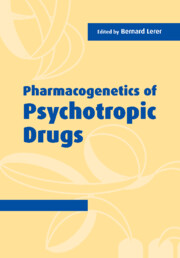Book contents
- Frontmatter
- Contents
- List of contributors
- Part I Introduction
- Part II Clinical background and research design
- Part III Molecular background
- Part IV Pharmacokinetics
- Part V Specific psychotropic drugs and disorders
- 10 Clozapine response and genetic variation in neurotransmitter receptor targets
- 11 Genetic factors underlying drug-induced tardive dyskinesia
- 12 Functional gene-linked polymorphic regions in pharmacogenetics
- 13 Alternative phenotypes and the pharmacogenetics of mood and anxiety disorders
- 14 Pharmacogenetics of anxiolytic drugs and the GABA–benzodiazepine receptor complex
- 15 Genetic factors and long-term prophylaxis in bipolar disorder
- 16 Genetic influences on responsiveness to anticonvulsant drugs
- 17 Apolipoprotein E as a marker in the treatment of Alzheimer's disease
- 18 Genetic variation and drug dependence risk factors
- Part VI Pharmacogenetics and brain imaging
- Part VII Industry perspectives
- Index
10 - Clozapine response and genetic variation in neurotransmitter receptor targets
from Part V - Specific psychotropic drugs and disorders
Published online by Cambridge University Press: 20 August 2009
- Frontmatter
- Contents
- List of contributors
- Part I Introduction
- Part II Clinical background and research design
- Part III Molecular background
- Part IV Pharmacokinetics
- Part V Specific psychotropic drugs and disorders
- 10 Clozapine response and genetic variation in neurotransmitter receptor targets
- 11 Genetic factors underlying drug-induced tardive dyskinesia
- 12 Functional gene-linked polymorphic regions in pharmacogenetics
- 13 Alternative phenotypes and the pharmacogenetics of mood and anxiety disorders
- 14 Pharmacogenetics of anxiolytic drugs and the GABA–benzodiazepine receptor complex
- 15 Genetic factors and long-term prophylaxis in bipolar disorder
- 16 Genetic influences on responsiveness to anticonvulsant drugs
- 17 Apolipoprotein E as a marker in the treatment of Alzheimer's disease
- 18 Genetic variation and drug dependence risk factors
- Part VI Pharmacogenetics and brain imaging
- Part VII Industry perspectives
- Index
Summary
OVERVIEW
Clozapine is an atypical antipsychotic drug with unique clinical features, particularly in treatment resistant schizophrenia. Between 10 and 60% of patients resistant or intolerant to treatment with other antipsychotic drugs respond to clozapine. Reliable genetic prediction of which patients will respond would have major economic, clinical, and safety implications. Candidate genes of potential utility in pharmacogenetic tests can be identified from clozapine's neurotransmitter targets. Clozapine has a complex pattern of interaction with neurotransmitter receptors, with high affinity for dopamine D4, serotonin (5-HT) 1A, 2A, 2C, 6, and 7, histamine H1, muscarinic M1 and α1- and α2-adrenoceptors. Exactly which of these receptors mediates clozapine's clinical efficacy is unknown, but the involvement of 5-HT is very likely. Despite the lack of formal evidence from genetic epidemiology, it is reasonable to hypothesize that genetic variation in these receptors influences clinical response to clozapine by altering receptor function in some way. At most of these receptors, clozapine is a neutral antagonist, but at others, such as 5-HT2C, it has inverse agonist activity. Further complexity comes from the unusual regulation of several of these receptors, with evidence for functional alternative splicing of 5-HT2C, polymorphic imprinting of 5-HT2A, and unusual downregulation of at least three 5-HT receptors through clozapine-induced cellular internalization. Most of clozapine's receptor targets have been tested in some way for association with clinical response using a case-control allelic association design. Polymorphisms in two genes, for 5-HT2A and dopamine D3, have been implicated in more than one study.
Keywords
- Type
- Chapter
- Information
- Pharmacogenetics of Psychotropic Drugs , pp. 217 - 244Publisher: Cambridge University PressPrint publication year: 2002

